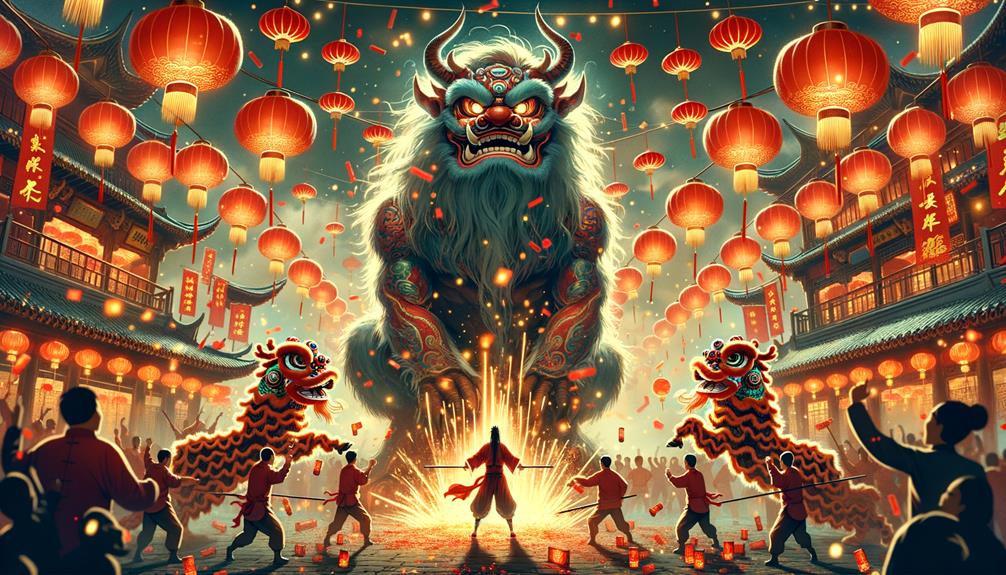
when Horror Yearbook – The Legend of Nian tells one of the most famous and enduring stories from Chinese folklore. It explains the origins of the Chinese New Year and reveals how fear, tradition, and wisdom formed one of the most colorful and widely celebrated festivals in the world. Rooted in the heart of ancient village life, the legend continues to influence modern customs, decorations, and family gatherings across Chinese communities worldwide.
Long ago in ancient China, villagers believed a terrifying creature lived high in the mountains or deep beneath the sea. They called it Nian, which means year in Chinese. This beast had a lion-like face, sharp horns, and immense strength. It slept for most of the year but would wake up every Lunar New Year’s Eve and descend upon villages. During its rampages, Nian attacked people, trampled crops, and devoured livestock. The villagers feared the day it would come. Each year, they would pack up their belongings and flee to the mountains to avoid its wrath. No one knew how to stop it, and over time, the tradition of fleeing became part of the village’s yearly cycle.
“Read about: M3GAN 2.0 Unleashes the Next Generation of Fear”
According to legend, everything changed one year when a mysterious old man visited a remote village. While everyone else prepared to flee, he stayed behind. The villagers warned him of the danger, but he remained calm. He hung bright red paper on the door, lit lanterns, and prepared a bundle of firecrackers. That night, Nian came down as usual. But instead of quiet, empty homes, it was met with flashing red decorations and loud explosions. Startled and frightened, the beast ran back into the wilderness. When the villagers returned the next day, they were amazed to find their homes untouched. This was the beginning of a new understanding. The villagers realized that Nian feared the color red, loud sounds, and bright lights. These became the foundation for what would later evolve into Chinese New Year celebrations.
The discovery changed everything. Red paper cuttings and couplets began appearing on doors. Lanterns were hung from houses and fireworks lit the skies. These new practices brought joy and confidence to the people. They no longer needed to run from Nian. Instead, they could welcome the new year with strength and unity. The use of firecrackers became especially popular. Entire towns were lit with bursts of sound and color. Families gathered together to eat, tell stories, and share in the victory of another year survived. The tale of Nian was passed down from grandparents to grandchildren. Although the story may have changed slightly over generations, its message remained the same. Courage, community, and clever thinking could overcome even the most frightening challenges.
“Read more: Sky Bridge to the Middle East: Virgin Australia’s New Brisbane–Doha Route”
Many of the symbols used in modern Chinese New Year celebrations are inspired directly by the legend of Nian. Red is seen as a protective color. It appears in envelopes, clothing, and decorations. Loud noises are encouraged through drums, lion dances, and fireworks. The lion dance, a performance often seen during festivals, may also have been inspired by the image of Nian. The large head, the rhythmic movements, and the intense drumbeats were all believed to scare away evil spirits. These performances are now part of a festive tradition but began as acts of defense. Even the family reunion dinner on Lunar New Year’s Eve carries echoes of the past. It celebrates survival and togetherness, a reminder of the time when unity was the key to resisting danger.
As Chinese communities migrated and spread around the world, so did the story of Nian. Today, festivals in cities like San Francisco, London, and Sydney include elements of the legend. Streets are filled with red banners, fireworks are launched into the sky, and lion dancers perform for crowds of thousands. Cultural education programs often use the tale to teach children about Chinese values and traditions. Schools retell the story in plays and readings. It has become a gateway for understanding deeper aspects of Chinese heritage and the significance of Lunar New Year. The legend has also inspired books, animated films, and public art. Though rooted in ancient folklore, it continues to evolve with each generation. Nian has gone from being a feared monster to a symbol of hope, resilience, and celebration.
The tale of Nian shows the power of storytelling in shaping collective memory and tradition. Rather than fading into obscurity, the legend is brought to life every year through action, color, sound, and family rituals. It connects modern lives with ancient wisdom. Communities have used this story not only to celebrate but also to reflect. While firecrackers and red lanterns serve festive roles, they also carry historical meaning. People remember what it was like to face the unknown and to overcome fear with knowledge and courage. Modern festivals may look different, but their heart remains the same. Through storytelling, Nian continues to walk among us each year. But now, instead of fear, it brings people together in celebration of another year well-lived.